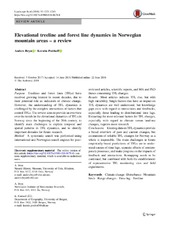Elevational treeline and forest line dynamics in Norwegian mountain areas - a review
Peer reviewed, Journal article
Published version

Åpne
Permanent lenke
https://hdl.handle.net/1956/19261Utgivelsesdato
2018-06-22Metadata
Vis full innførselSamlinger
- Department of Geography [634]
Originalversjon
https://doi.org/10.1007/s10980-018-0670-8Sammendrag
Purpose Treelines and forest lines (TFLs) have received growing interest in recent decades, due to their potential role as indicators of climate change. However, the understanding of TFL dynamics is challenged by the complex interactions of factors that control TFLs. The review aims to provide an overview over the trends in the elevational dynamics of TFLs in Norway since the beginning of the 20th century, to identify main challenges to explain temporal and spatial patterns in TFL dynamics, and to identify important domains for future research. Method A systematic search was performed using international and Norwegian search engines for peer-reviewed articles, scientific reports, and MA and PhD theses concerning TFL changes. Results Most articles indicate TFL rise, but with high variability. Single factors that have an impact on TFL dynamics are well understood, but knowledge gaps exist with regard to interactions and feedbacks, especially those leading to distributional time lags. Extracting the most relevant factors for TFL changes, especially with regard to climate versus land-use changes, requires more research. Conclusions Existing data on TFL dynamics provide a broad overview of past and current changes, but estimations of reliable TFL changes for Norway as a whole is impossible. The main challenges in future empirically-based predictions of TFLs are to understand causes of time lags, separate effects of contemporary processes, and make progress on the impacts of feedback and interactions. Remapping needs to be continued, but combined with both the establishment of representative TFL monitoring sites and field experiments.
